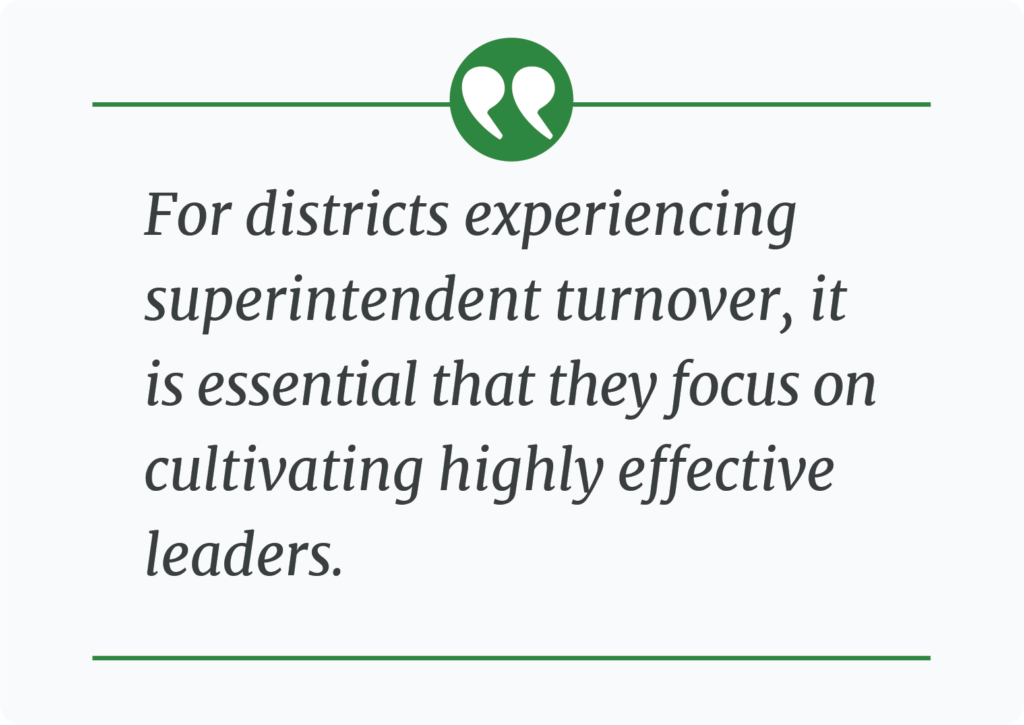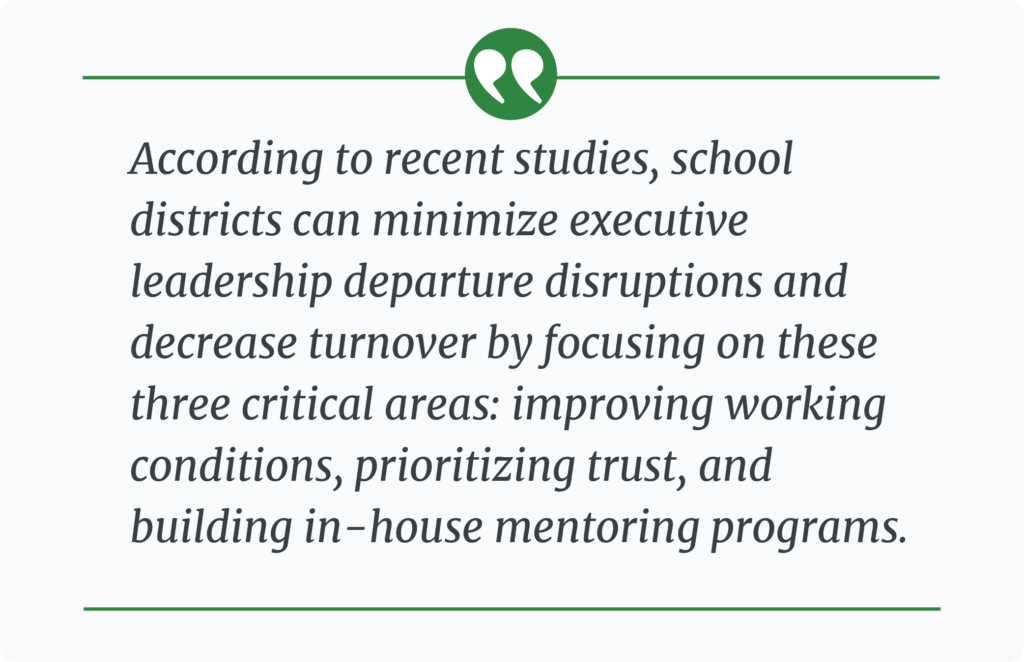by Karen Baptiste
Superintendent turnover is a complex phenomenon that is not easily addressed or discussed widely. Perhaps because teacher turnover rates continue to rise exponentially, it can be a feasible explanation as to why superintendent turnover has not received as much attention. This lack of attention has yielded data gaps about the percentage of superintendents that are resigning annually.
There are conflicting reports about superintendent turnover, which make it difficult to get a handle on effective ways to address it. The most recent data from Education Resource Strategies found that during the 2021-2022 school year, approximately 25% of superintendents had resigned from their position. Another study from ILO Group found that when examining the nation’s 500 largest school districts, 37% had experienced superintendent turnover. Conversely, RAND reported in 2022 that 85% of superintendents cited being happy in their role even though the job came with high levels of stress. Regardless, attrition is increasing and can create significant challenges for schools and communities. Superintendent turnover can have negative impacts on schools and student achievement because they set the vision and direction for the school district. When a superintendent leaves, it can be challenging to maintain that vision and ensure that the district continues to make progress towards its goals.[1]
Another study from ILO Group found that when examining the nation’s 500 largest school districts, 37% had experienced superintendent turnover. Conversely, RAND reported in 2022 that 85% of superintendents cited being happy in their role even though the job came with high levels of stress. Regardless, attrition is increasing and can create significant challenges for schools and communities. Superintendent turnover can have negative impacts on schools and student achievement because they set the vision and direction for the school district. When a superintendent leaves, it can be challenging to maintain that vision and ensure that the district continues to make progress towards its goals.[1]
For districts experiencing superintendent turnover, it is essential that they focus on cultivating highly effective leaders. This process requires a thorough search, evaluation, and selection process, which can be complicated because the pool of qualified candidates may be limited, but also it can be expensive, with costs associated with recruitment, hiring, and onboarding.[2] In addition, the new superintendent may require additional support, training, and resources as they get settled into their new role, especially if the previous superintendent left abruptly. This blog summarizes three ways districts can begin to consider how they are reducing superintendent turnover.
One way to mitigate these burdensome costs is to ensure that district and leader capacity is not lost. Having a succession plan in place for managing superintendent transitions can keep the district operating and functioning smoothly during periods of change. Succession planning should include evaluation models that are monitored and analyzed annually.[3] Tracking longitudinal data can support leaders with preempting  any necessary improvements.[4]
any necessary improvements.[4]
According to recent studies, school districts can minimize executive leadership departure disruptions and decrease turnover by focusing on these three critical areas:
Improve Working Conditions
Frequent superintendent turnover can create instability within the school district, as each new superintendent may have different goals, priorities, and management styles.[5] This can lead to confusion, miscommunication, and uncertainty among board members, staff, and the community. Superintendents often leave their positions due to poor working conditions, such as high stress levels, lack of support, unclear expectations from the school board, and inadequate resources.[6] By providing multi-year incentives while simultaneously improving work conditions, school districts can retain talented superintendents. School boards should consider putting measures in place to reduce the variabilities that exist for the superintendent by hiring sufficient and qualified central staff members to balance out the workload and create a culture of distributive leadership.[7] An example would be to create a code of civility where the board and the superintendent can mutually agree upon how disagreements are handled to prevent resentment or harsh decisions. This process can be a trust generator where both parties feel respected, heard, and part of the decision-making.
Prioritize Trust
When a superintendent leaves, it can erode trust within the community. Parents, staff, and other stakeholders may feel that their voices have not been heard, and they may be skeptical of the school district’s ability to provide a stable and effective educational environment. Collecting feedback can improve the partnership between the superintendent and the school board to ensure alignment in how to best fulfill the district’s mission.[8] School boards should establish check-in systems that gather feedback from the superintendent about their experience and their needs that is not punitive but supportive. This can create a safe space for the superintendent to communicate their intentions and priorities. Clear communication can allow for feedback from principals, teachers, students, and families in advance of initiatives being implemented.
Build In-House Mentoring Programs
Mentoring is often overlooked by many industries or for those in the C-suite. Many studies espouse the benefits of mentoring and its benefits on job performance, retention, and work-life balance.[9] Another benefit to building an in-house mentoring program can strengthen the internal pipeline where school districts can develop a grow-your-own model.[10] Mentoring a superintendent can help them improve their communication, make tangible, effective changes, and build a thriving culture.[11] This can result in greater confidence and clarity on how to balance their responsibilities and lead effectively.
With a fast pace evolving society, functional leadership is increasingly in demand. Leaders are expected to keep up or even ahead of the changes with competencies that allow for effective leadership to be present. School boards must support superintendents through asset-based evaluations that show their strengths, and realistic goals for improvement that motivates the superintendent to create a blueprint for success whereby they focus on filling the skills gap their team might have and build capacity in-house to increase retention rates.[12]
References
[1] ILO Group. (2022). The superintendent research project: pandemic leadership transitions. ILO Group. https://www.ilogroup.com/wp-content/uploads/2022/02/The-Superintendent-Research-Project_-Pandemic-Leadership-Transitions-2.pdf
[2] Reckler, L. (2022). How school boards choose a superintendent. Ed 100. https://ed100.org/blog/choosing-a-superintendent
[3] Mabry, A. (2023). Succession planning to prepare for the future. HRX. https://www.tasb.org/services/hr-services/hrx/other-hr/succession-planning-to-prepare-for-the-future.aspx
[4] Mabry, A. (2023). Succession planning to prepare for the future. HRX. https://www.tasb.org/services/hr-services/hrx/other-hr/succession-planning-to-prepare-for-the-future.aspx
[5] Brown, L., & Roberts, D. (2022). Superintendent turnover is skyrocketing. What school districts can do now to retain experienced educators. Smart Brief. https://corp.smartbrief.com/original/2022/02/superintendent-turnover-retain-experienced-educators
[6] Pillow, T., & Dusseault, Bree. (2022). Analysis: gut-check moment for school superintendents – toxic politics, demands for new services, struggles to deliver basics make “impossible job” harder than ever. The 74. https://www.the74million.org/article/analysis-gut-check-moment-for-supes-demands-for-new-services-struggles-to-deliver-the-basics-toxic-politics-make-impossible-job-harder-than-ever/
[7] Reckler, L. (2022). How school boards choose a superintendent. Ed 100. https://ed100.org/blog/choosing-a-superintendent
[8] Blad, E. (2022). Tips for building strong principal-superintendent relationships. Education Week. https://www.edweek.org/leadership/tips-for-building-strong-principal-superintendent-relationships/2022/03
[9] De Janasz, S., & Peiperl, M. (2015). CEOs need mentors too. Harvard Business Review. https://hbr.org/2015/04/ceos-need-mentors-too
[10] Blad, E. (2023). 3 benefits of superintendent mentoring programs. Education Week. https://www.edweek.org/leadership/3-benefits-of-superintendent-mentoring-programs/2023/06
[11] Blad, E. (2023). 3 benefits of superintendent mentoring programs. Education Week. https://www.edweek.org/leadership/3-benefits-of-superintendent-mentoring-programs/2023/06
[12] Marshall, J.M., & Ulrich, J.D. (2022). How to keep your superintendent: board factors related to superintendent retention and turnover. National School Boards Association. https://www.nsba.org/ASBJ/2022/august/online–superintendent
Karen Baptiste Ed.D. is a senior consultant at McREL International and a former special education teacher, instructional coach, and director who now works with K–12 schools across the U.S. to support improved teaching and learning with an emphasis on quality implementation of evidence-based instructional strategies for diverse learners, including helping teachers create learning environments that encourage student voice and ownership of learning. She is a co-author of The New Classroom Instruction That Works.

